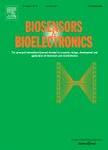版权所有:内蒙古大学图书馆 技术提供:维普资讯• 智图
内蒙古自治区呼和浩特市赛罕区大学西街235号 邮编: 010021

作者机构:Liaoning Univ Liaoning Prov Key Lab Green Synth & Preparat Chem Shenyang 110036 Peoples R China Nanyang Technol Univ Sch Phys & Math Sci Singapore 637371 Singapore Tianjin Univ Anal Ctr Tianjin 300072 Peoples R China Gen Hosp Northern Theater Command Dept Lab Med Ctr Shenyang 110016 Peoples R China
出 版 物:《BIOSENSORS & BIOELECTRONICS》 (Biosens. Bioelectron.)
年 卷 期:2025年第273卷
页 面:117173页
核心收录:
学科分类:0710[理学-生物学] 071011[理学-生物物理学] 07[理学] 0805[工学-材料科学与工程(可授工学、理学学位)] 0703[理学-化学] 0836[工学-生物工程]
基 金:National Natural Science Foundation of China Natural Science Foundation of Liaoning Province-Outstanding Youth Foundation [2022-YQ-14] China Scholarship Council (CSC)
主 题:Sensor array Polyionic complex micelles Thiols Biomarkers
摘 要:Array-based analysis allows for precise disease diagnosis by simultaneously detecting multiple biomarkers. However, most array sensing platforms rely on non-covalent interactions between sensors and analytes, which limits their sensitivity. This study enhances the sensitivity of array analysis for thiol biomarkers by incorporating polyion complex micelles into the sensor array design. Polyion complex micelles are formed through the selfassembly of carbon dots (CDs) and anionic diblock copolymers. The sensing detection process can occur inside the core of the micelle, the confined space and ionic environment within the core reduce the interaction distance between CDs, metal ions, and analytes, thereby significantly improving detection sensitivity while minimizing metal ions consumption. The developed array system can accurately identify multiple thiols across a broad concentration range (0.5-1000 mu M) with 100% accuracy. Additionally, support vector machine (SVM) analysis reveals a detection limit of approximately 0.1 mu M for individual thiol systems. Compared to non-micellar approaches, this micelle-based array reduces the detection limit for thiol biomarkers by 20-fold and decreases Ag+ usage by 40-fold. The system is suitable for both qualitative and quantitative analysis of thiol biomarkers, offering a powerful tool for the accurate diagnosis of thiol-related diseases.